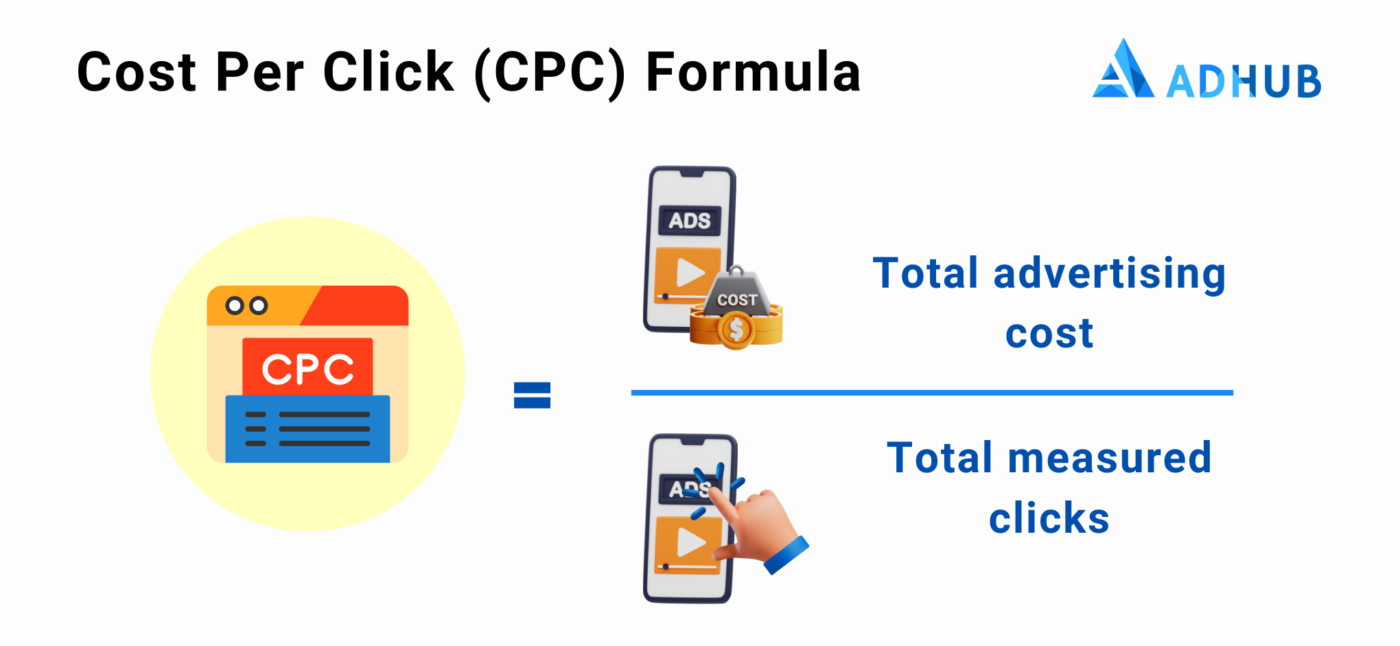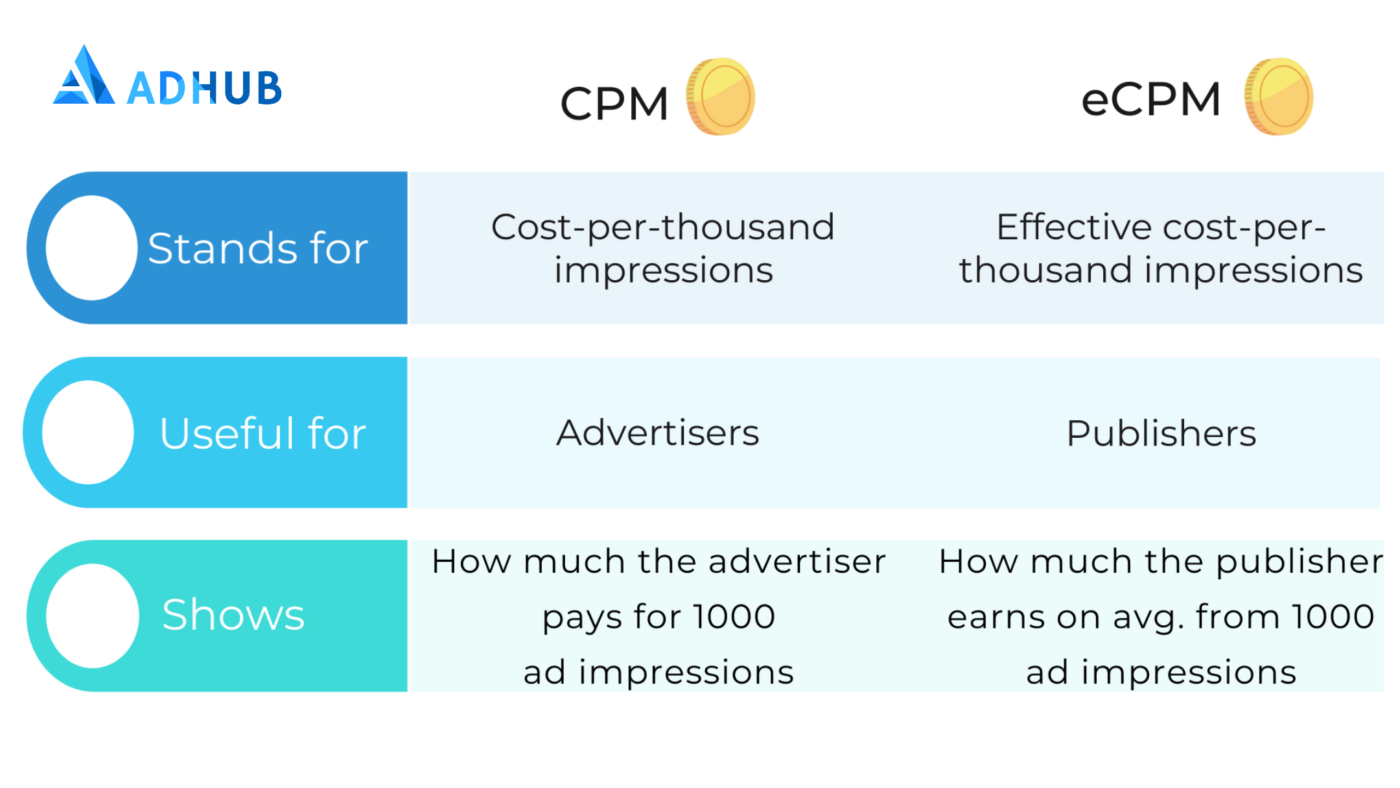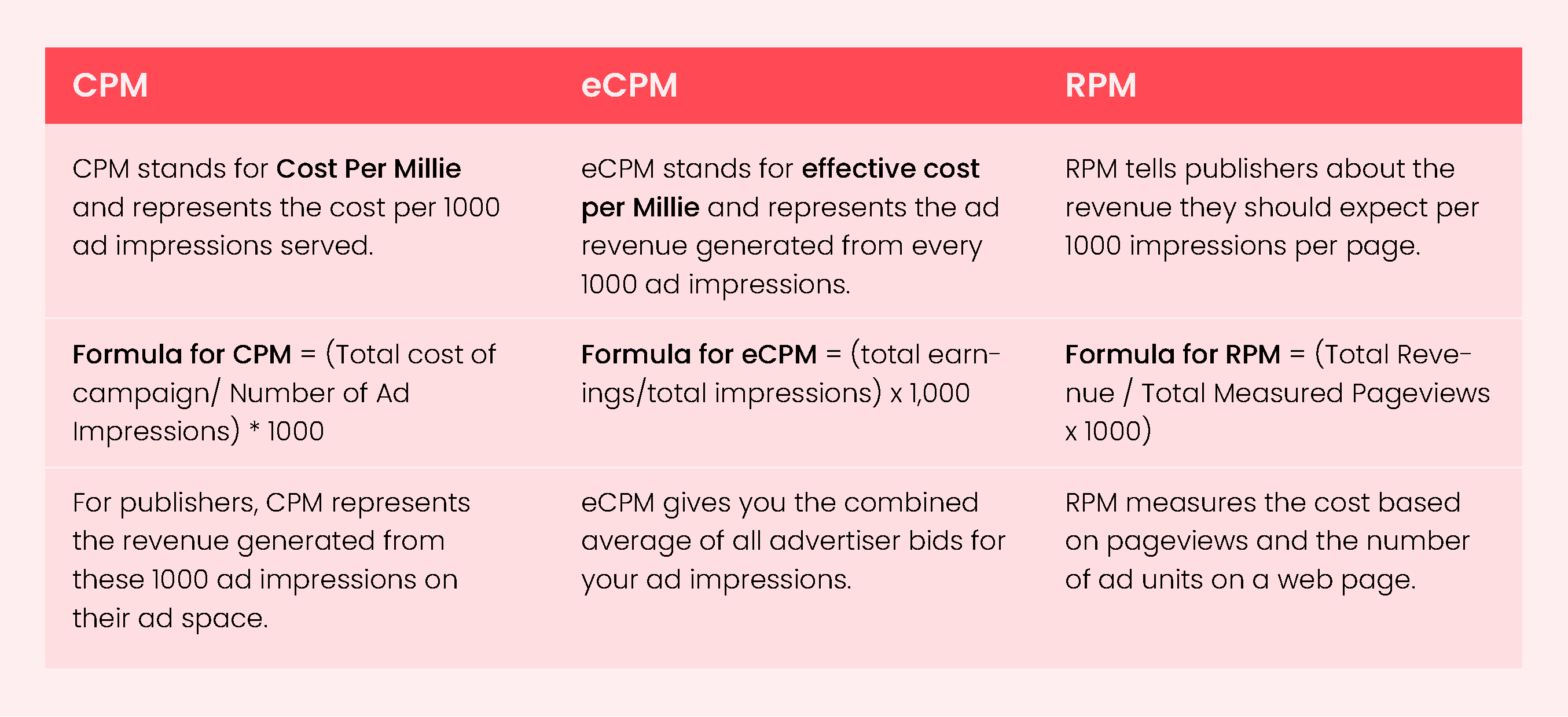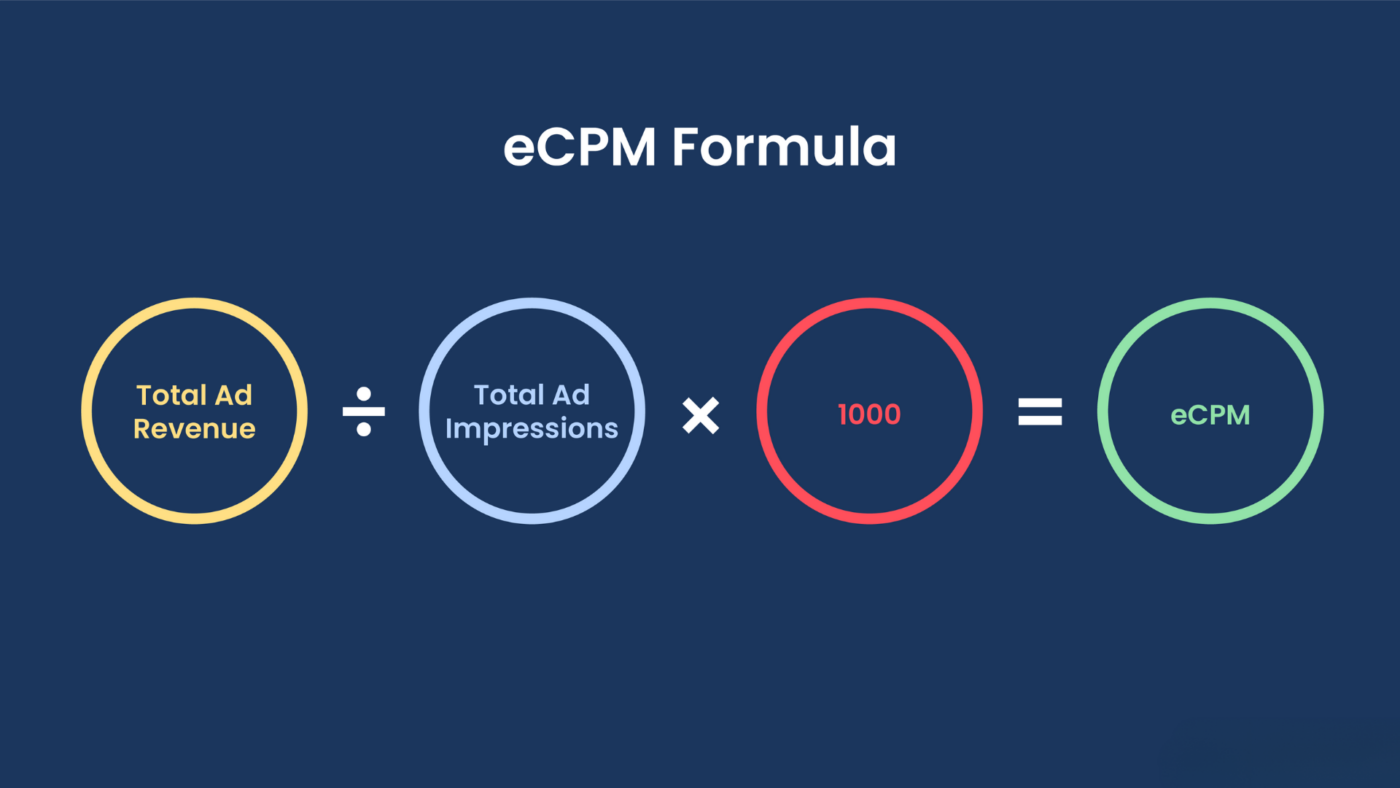In the world of digital advertising, understanding the metrics that determine the success of your campaigns is crucial. One such metric is Effective CPM (eCPM), which is an essential tool for advertisers and publishers alike. It helps you measure the efficiency of your campaigns across different pricing models and platforms. In this article, we’ll dive deep into what eCPM is, why it matters, and how to optimize it to maximize ad revenue.

The eCPM formula simplifies performance measurement across campaigns.
What is Effective CPM (eCPM)?
Effective CPM (eCPM) is a metric that helps advertisers and publishers understand the total revenue generated by an ad campaign, no matter what pricing model is used (such as CPM, CPC, or CPA). It provides a way to compare ad performance across different models by expressing everything as a standardized CPM.
The formula for eCPM is:
eCPM=Total EarningsTotal Impressions×1000eCPM = frac{{text{{Total Earnings}}}}{{text{{Total Impressions}}}} times 1000
eCPM=Total ImpressionsTotal Earnings×1000
This formula helps standardize ad campaign performance regardless of whether you are paying per impression (CPM), per click (CPC), or per action (CPA).
Why eCPM is Important
eCPM allows advertisers to gauge the overall profitability of a campaign without needing to focus on one specific metric. Whether your goal is increasing clicks, conversions, or brand exposure, eCPM helps you assess the true performance of your advertising efforts.
By calculating eCPM, you can make better decisions when allocating your advertising budget, ensuring that you’re investing in the most cost-effective channels.
eCPM vs CPM: Key Differences
While CPM (Cost Per Thousand Impressions) and eCPM may seem similar, they are different in important ways.
- CPM refers to the cost of 1,000 impressions, where advertisers pay for the number of times their ad is displayed, regardless of interaction.
- eCPM, on the other hand, standardizes the cost across all pricing models (CPM, CPC, CPA), offering a more comprehensive view of campaign performance.
Here’s a visual comparison of the two metrics:

Key differences between CPM and eCPM explained visually.
Why You Should Care About eCPM
eCPM is particularly useful for advertisers running multi-platform campaigns. If you are using a mix of display ads, video ads, and social media ads, eCPM helps you evaluate and compare performance across all these platforms, ensuring you’re making data-driven decisions.
It’s the perfect metric for comparing campaigns that use different payment models, so you can see which campaign is delivering the best return on investment (ROI).
Why is eCPM Important?
Effective CPM is more than just a formula—it’s a powerful tool that offers several key benefits:
- Maximized Ad Revenue: By standardizing revenue across different pricing models, eCPM provides a clearer picture of which campaigns are performing best and helping you optimize your ad spend.
- Cross-Platform Comparison: Advertisers often use multiple ad networks, including Google AdSense, Facebook Ads, and programmatic ads. eCPM allows you to evaluate performance across platforms and decide where to invest your resources for maximum returns.
- Better Decision Making: Whether you’re running a campaign focused on brand awareness or direct conversions, understanding eCPM helps you assess if you’re getting the right amount of visibility and engagement for your investment.
“In a highly competitive ad ecosystem, eCPM offers an invaluable, consolidated metric to monitor campaign success.”
Strategies to Optimize eCPM
Maximizing your eCPM means enhancing the efficiency of your campaigns. There are several ways to boost eCPM, and implementing the right strategies can significantly increase your revenue.
1. Improve Ad Quality
The quality of your ads has a direct impact on how well they perform. High-quality, engaging ads drive better user interaction, leading to more clicks and higher engagement rates, which ultimately boosts eCPM.
Best Practices for High-Quality Ads:
- Use compelling visuals and clear calls-to-action (CTAs).
- Experiment with video ads, as they typically have better engagement rates than static banners.
- Optimize ads for mobile users, as mobile advertising continues to dominate the digital space.
2. Focus on High-Value Inventory
Premium ad placements tend to yield better results in terms of visibility and engagement, which in turn leads to a higher eCPM.
Consider these high-value ad placements:
- Above the fold (top of the page)
- In-content or native ads
- Exclusive sponsorships with well-targeted audiences
By targeting premium inventory, you can improve your ad visibility, which often leads to more user interaction and better eCPM rates.
3. Experiment with Pricing Models
While eCPM offers a way to compare different pricing models, choosing the right pricing model for your campaign can directly influence your overall revenue. Some models work better than others based on your campaign objectives.
- CPC (Cost Per Click): Ideal for driving traffic, but may result in higher eCPM if users frequently click your ads.
- CPA (Cost Per Action): Works well if your goal is conversions, and it often results in a better eCPM because it considers the actual actions taken by users.
- CPM (Cost Per Thousand Impressions): Useful for brand awareness campaigns with a large volume of impressions, but typically offers a lower eCPM unless paired with quality targeting.
By analyzing your campaign’s goals and audience behavior, you can choose the pricing model that best aligns with your objectives, improving your eCPM in the process.

Optimizing ad placements for maximum eCPM efficiency.
4. Monitor and Adjust Campaigns Regularly
Regular optimization is crucial for maintaining high eCPM performance. Use advanced analytics tools to track how your campaigns are performing, and adjust accordingly.
Key metrics to monitor include:
- Impression volume: Are you reaching enough people with your ads?
- Click-through rate (CTR): A higher CTR generally indicates better engagement.
- Ad frequency: Avoid overexposing your audience to the same ad too often, which can result in ad fatigue.
Tools like Google Ads Manager and Facebook Ads Manager offer robust tracking and insights to help you optimize your campaigns.
Challenges with eCPM
While eCPM is an invaluable metric, there are challenges that come with using it effectively:
- Fraudulent Traffic: Bots and other fraudulent activities can inflate impression numbers, making it difficult to assess true campaign performance.
- Impression Quality: Not all impressions are valuable. Some may be displayed in places where users are unlikely to engage.
- Fluctuating Demand: Ad inventory can be unpredictable, affecting CPM rates and your overall eCPM performance.
Solutions to Overcome Challenges
To address these challenges, consider implementing strategies such as:
- Fraud detection tools like DoubleVerify and Moat to monitor and prevent invalid traffic.
- Improved targeting to ensure your ads are reaching the right audience.
- Analytics tools like Google Analytics and Adjust to measure performance and adjust strategies in real-time.
By adopting these solutions, you can mitigate potential issues and optimize your eCPM performance.
Would you like to continue with the second half of the article, including future trends and FAQs?
Future Trends in eCPM
As the digital advertising landscape continues to evolve, several emerging trends are poised to shape how eCPM is calculated and optimized. Staying ahead of these trends can help you further enhance the performance of your campaigns and drive more revenue.
1. The Rise of Programmatic Advertising
Programmatic advertising, which automates the buying and selling of ad inventory, is rapidly gaining ground. This automated process uses data to target ads more effectively, resulting in higher engagement and better eCPM.
By leveraging programmatic tools and real-time bidding (RTB), advertisers can optimize ad placements dynamically, maximizing the return on each impression. As more brands embrace programmatic, it’s essential to monitor eCPM closely to ensure optimal performance.
“Programmatic advertising allows for smarter ad placements that are data-driven and more effective, which in turn drives higher eCPM.”
2. AI and Machine Learning in Ad Targeting
Artificial Intelligence (AI) and machine learning are revolutionizing how advertisers optimize their campaigns. AI-powered algorithms can analyze vast amounts of data to predict the best-performing ads, adjust targeting in real-time, and boost eCPM by ensuring ads are shown to the right audience at the right time.
For example, platforms like Google Ads and Facebook Ads are integrating machine learning to automatically adjust bids and placements for better performance. As these technologies continue to evolve, they will further improve eCPM by refining the ad targeting process.
3. Mobile-First Advertising
With mobile traffic now accounting for over half of all internet traffic, mobile advertising is becoming increasingly important. Mobile-first strategies are now essential for any advertiser looking to maximize their reach and increase eCPM.
Mobile users are often more engaged with apps and mobile websites, which can lead to higher click-through rates (CTR) and ultimately a higher eCPM. Therefore, focusing on mobile-friendly ad formats and optimizing for mobile platforms is a key strategy for the future.

Mobile-first strategies can significantly increase your eCPM performance.
4. Ad Blocker Impact and Solutions
One of the ongoing challenges for online advertisers is the growing use of ad blockers, which affect both impressions and overall ad visibility. This trend can lower the number of impressions, impacting your eCPM rates.
To counter this, many advertisers are exploring native advertising or integrating more non-intrusive ad formats, like sponsored content, that bypass ad blockers while still delivering effective messages.
FAQs About eCPM
1. How is eCPM calculated?
eCPM is calculated by dividing your total earnings by the total impressions your ads generated, then multiplying by 1000. The formula is:
eCPM=Total EarningsTotal Impressions×1000eCPM = frac{{text{{Total Earnings}}}}{{text{{Total Impressions}}}} times 1000
eCPM=Total ImpressionsTotal Earnings×1000
This metric allows advertisers to compare different campaigns, regardless of the pricing model used.
2. What is the difference between eCPM and CPM?
While CPM is the cost of 1,000 impressions, eCPM standardizes the cost of ad campaigns across all pricing models (CPC, CPM, CPA), providing a more comprehensive view of ad performance.
eCPM allows advertisers to evaluate the total revenue generated per 1,000 impressions, even if they use multiple pricing models.
3. How can I increase my eCPM?
There are several ways to increase your eCPM:
- Improve the quality of your ads by using compelling visuals and clear CTAs.
- Focus on premium ad placements to ensure better visibility.
- Experiment with different pricing models and optimize for your campaign’s goals.
- Use targeting tools and data analytics to refine your audience.
4. What are some common challenges with eCPM?
Challenges include fraudulent traffic, which can inflate impressions, and impression quality, where low-quality impressions don’t lead to engagement. Additionally, fluctuating ad demand can cause variations in CPM rates, impacting overall eCPM performance.
5. How does programmatic advertising impact eCPM?
Programmatic advertising optimizes ad placements automatically using data and machine learning. It can significantly improve eCPM by targeting the right audience with the right ad at the right time, resulting in higher engagement and revenue.
Conclusion
Effective eCPM is a powerful tool for evaluating ad performance, ensuring that advertisers and publishers are maximizing their revenue. By understanding how eCPM works, how to calculate it, and how to optimize it, you can ensure your campaigns deliver the best results.
In the ever-evolving world of digital advertising, staying ahead of trends like programmatic advertising, mobile-first strategies, and AI-driven targeting will further enhance your eCPM and overall campaign success.
As you implement the strategies shared in this article, remember that consistent monitoring, optimization, and experimentation are key to maintaining high-performing campaigns that deliver maximum returns.
